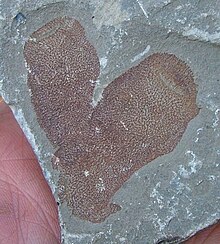Hazeliidae is an extinct family of spicular Cambrian sea sponges known from the Burgess Shale, the Marjum Formation of Utah,[3] and possibly Chengjiang.[1] It was described by Charles Walcott in 1920.
| Hazeliidae Temporal range:
| |
|---|---|

| |
| A specimen of Hazelia at the Mount Stephen Trilobite Beds | |
| Scientific classification | |
| Domain: | Eukaryota |
| Kingdom: | Animalia |
| Phylum: | Porifera |
| Class: | Demospongiae |
| Order: | †Protomonaxonida |
| Family: | †Hazeliidae Walcott, 1920 |
| Genera | |
| |
References
edit- ^ a b Botting, J. (2007). "'Cambrian' demosponges in the Ordovician of Morocco: Insights into the early evolutionary history of sponges". Geobios. 40 (6): 737–748. doi:10.1016/j.geobios.2007.02.006.
- ^ Rigby, J. K. (1986). "Sponges of the Burgess shale (Middle Cambrian), British Columbia". Palaeontographica Canadiana (2).
- ^ J. Keith Rigby; Lloyd F. Gunther; Freida Gunther (1997). "The First Occurrence of the Burgess Shale Demosponge Hazelia palmata Walcott, 1920, in the Cambrian of Utah". Journal of Paleontology. 71 (6): 994–997. doi:10.1017/S0022336000035976. JSTOR 1306598. S2CID 130706440.